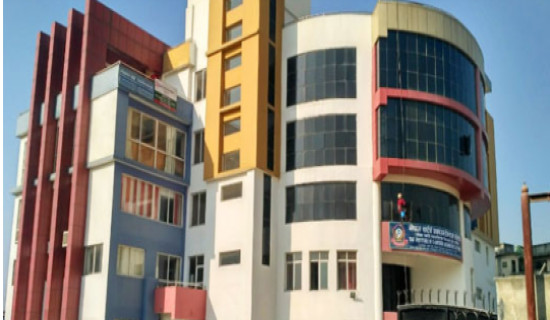- Thursday, 8 January 2026
'A Road To A Village' Reaches Beijing
"Does Nepal produce its own movies? The one I saw today is a good one." This question from a Chinese audience during an interaction on the film 'A Road to a Village' (Gaun Aayako Bato) startled Nabin Subba, director and producer of the movie. He calmly responded to the girl, who had been in Nepal for a couple of days a few years ago, that the southern neighbour of China produces about 150 movies a year, and it's a promising industry.
This is the first time any Nepali feature movie has premiered at the Beijing Film Festival (BJIFF) 2024, which is concluding its 14th edition on Friday, April 26. However, a few short movies and documentaries have been premiered at various festivals and occasions in different Chinese cities. The premier of 'Gaun Aayako Bato' saw a good number of audiences who passionately participated in the interaction with Subba and another producer, Amod Rai. This has created awareness about the Nepali movies and cinema industry at the festival, where companies and organisations involved in film production, equipment, logistics, and promotion from many countries, including South Korea, Brazil, and Thailand, have exhibited their products and policies. These countries have set up their stalls at one of the largest film festivals in the Asia-Pacific region to lure moviemakers to go there for film shoots or to hire equipment and technology.
'Gaun Aayako Bato' has been memorable for Chinese and foreign spectators for four reasons: it presents contradictions between traditional and cultural products and capitalism; it was the first feature film to be premiered in the BJIFF; it has artists who look like Chinese; and it was produced through community funding. A Japanese national asked this scribe whether Chinese artists worked in the movie. "They looked like us," he said. The lead characters of the film, Dayahang Rai, Pashupati Rai, and Prasan Rai, look like Chinese.
Subba and Rai expressed satisfaction over the reactions to the movie and the good reviews that it drew from the audience. Subba has created a turning point in the Nepali entertainment industry with 'Numafung' in 2001 and the teleserial 'Dalan' in 2008. 'Gaun Aayako Bato', releasing in Nepal on June 3 this year, is a moving story and a compelling journey to a village in an eastern district where there is a contradiction between rural customs and modern development. While the story revolves around the changes and maladies brought about by the newly built road to the village, the film tells a heartening story of the relationship between the parents and their son.
The movie successfully presented how the road introduced modernization to the village through carbonated drinks, hip-hop songs, sunglasses, and television.
Meanwhile, it aptly describes the factors that force a youth to leave the village in search of a job abroad. There are a few livelihood options in the villages, but at times they become demotivating and humiliating, at worst. Most of the time, characters talk about big cities and time. Life in the hills is very hard and less rewarding.
The 'Gaun Aayako Bato' film shows that materialistic achievements give a kind of superiority in society. Not only the village leaders and returnee migrants but also the kids exercise it as Bindrey (the son enacted by Prasan) makes his friends stand in a queue and forces them to follow his orders when he gets a chance to have a bottle of carbonated drink. The evolution of the concept is exhibited through the symbol of eyeglasses—natural material, paper, photo film, and a pair of goggles that Bindrey dons at different times.
The film is funded through community sponsorship, which is a new model for Nepal and many other producers abroad. The money is raised from Nepali and Rai communities in Hong Kong, Macao, and elsewhere. "When I heard the story portraying the Rai community from Nabin, I was quite confused in the beginning. But after some contemplation, I thought it was a good story to develop into a cinema," said Amod, who is based in Hong Kong. He said that this model could prove sustainable in the long run. It creates community ownership over the cultural product.
Speaking at the interaction, Subba said that Nepal and China are trying to develop relations in multiple sectors, and art and culture could be a significant area for collaboration. He has found Chinese society more open to foreign movies and culture.
(Dhakal is a journalist at The Rising Nepal.)













-original-thumb.jpg)



